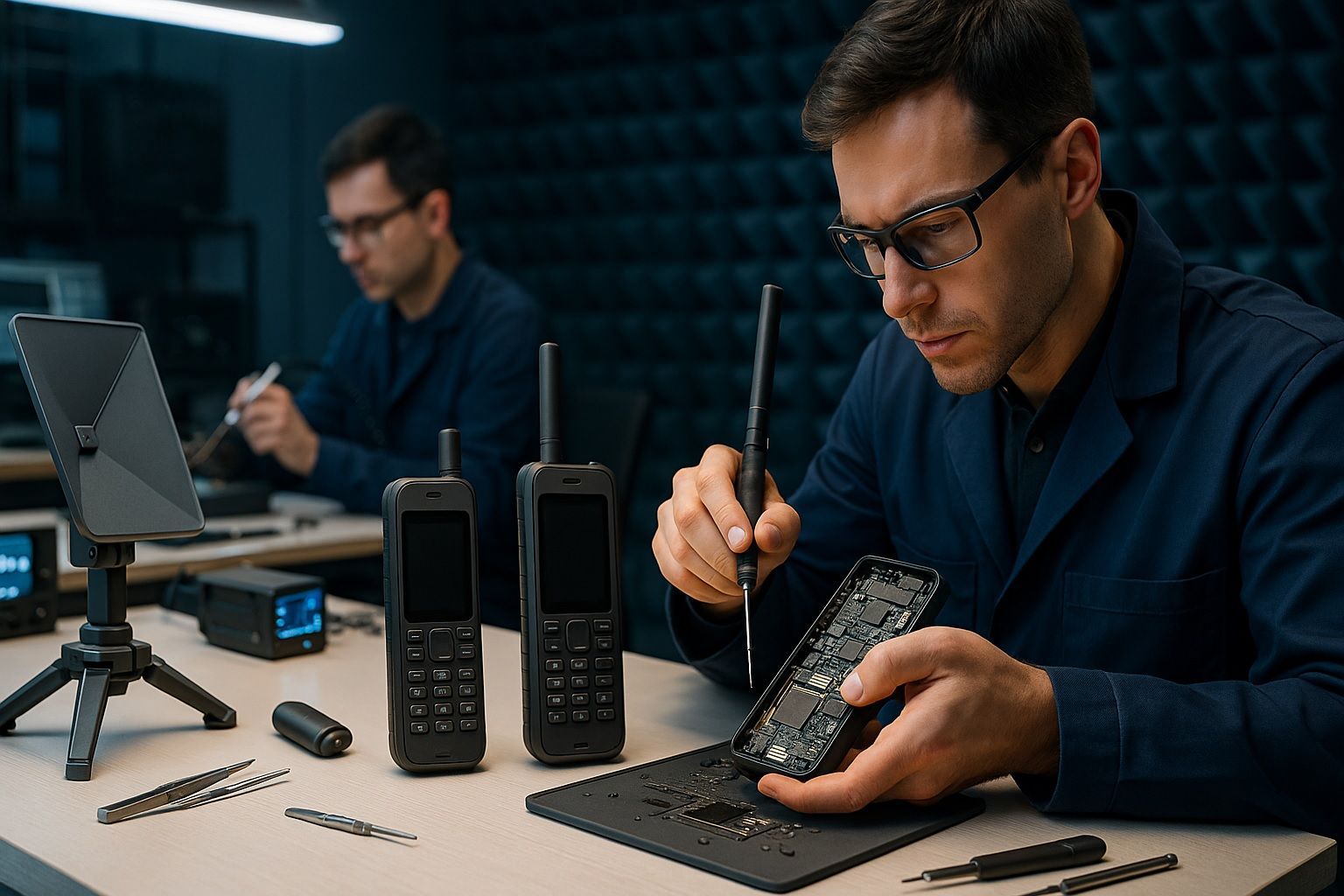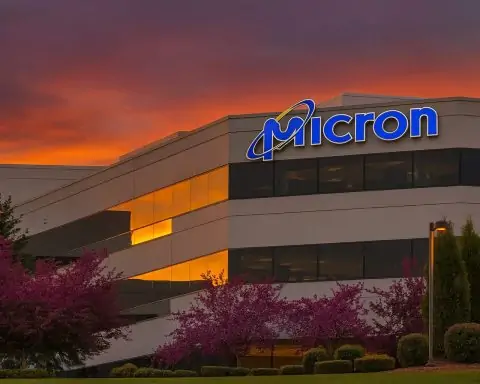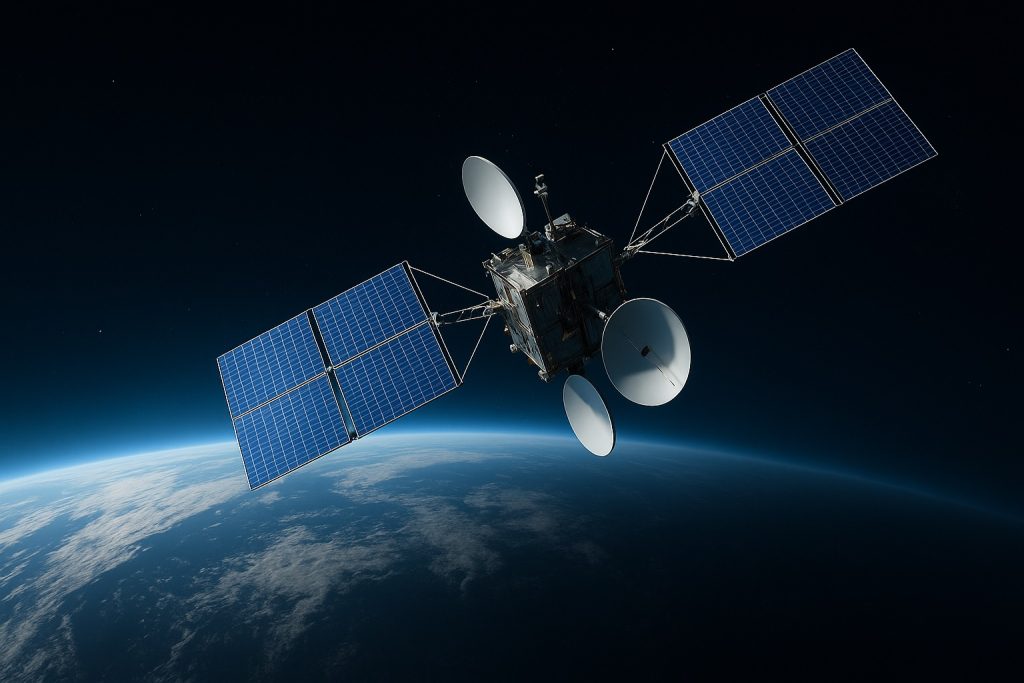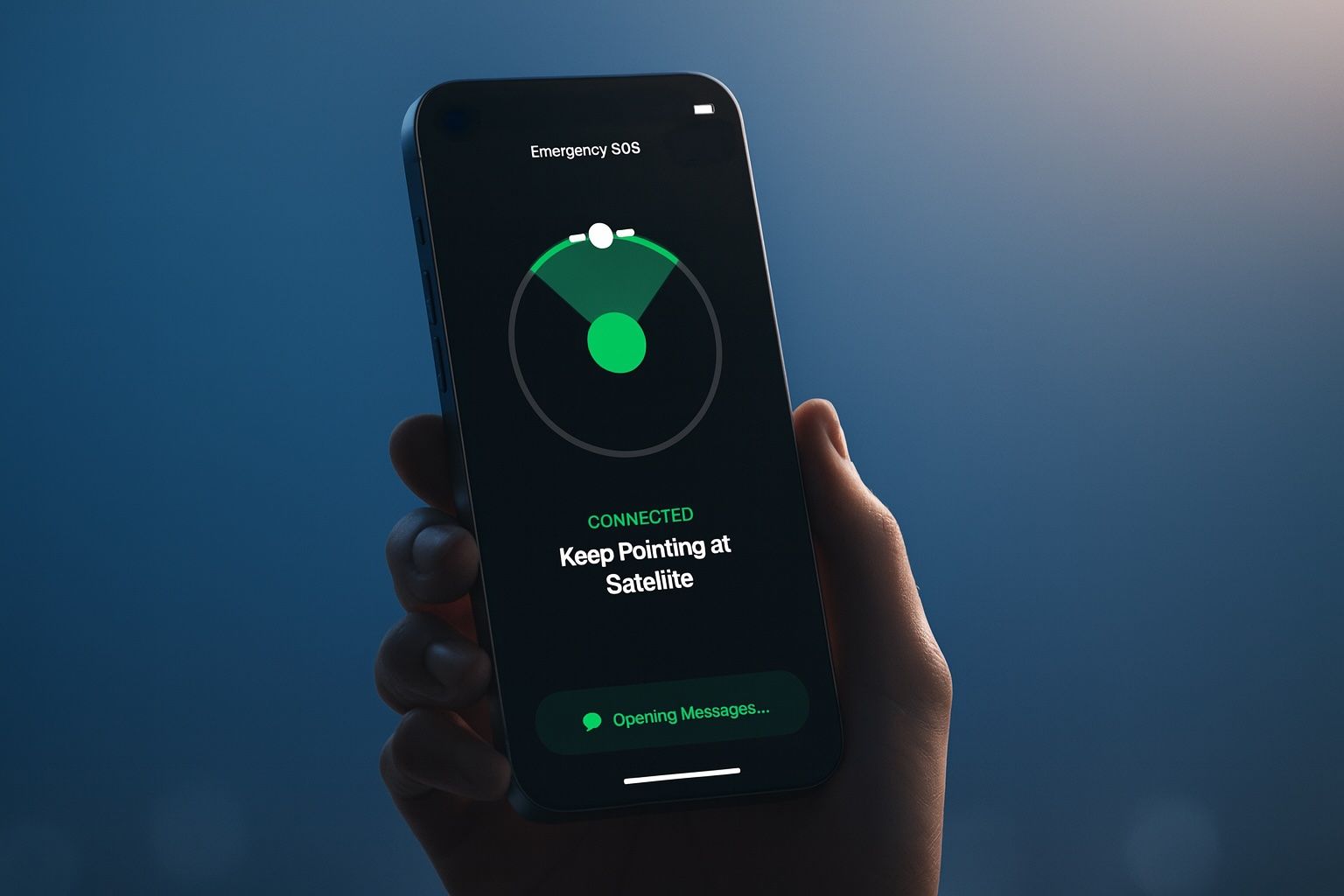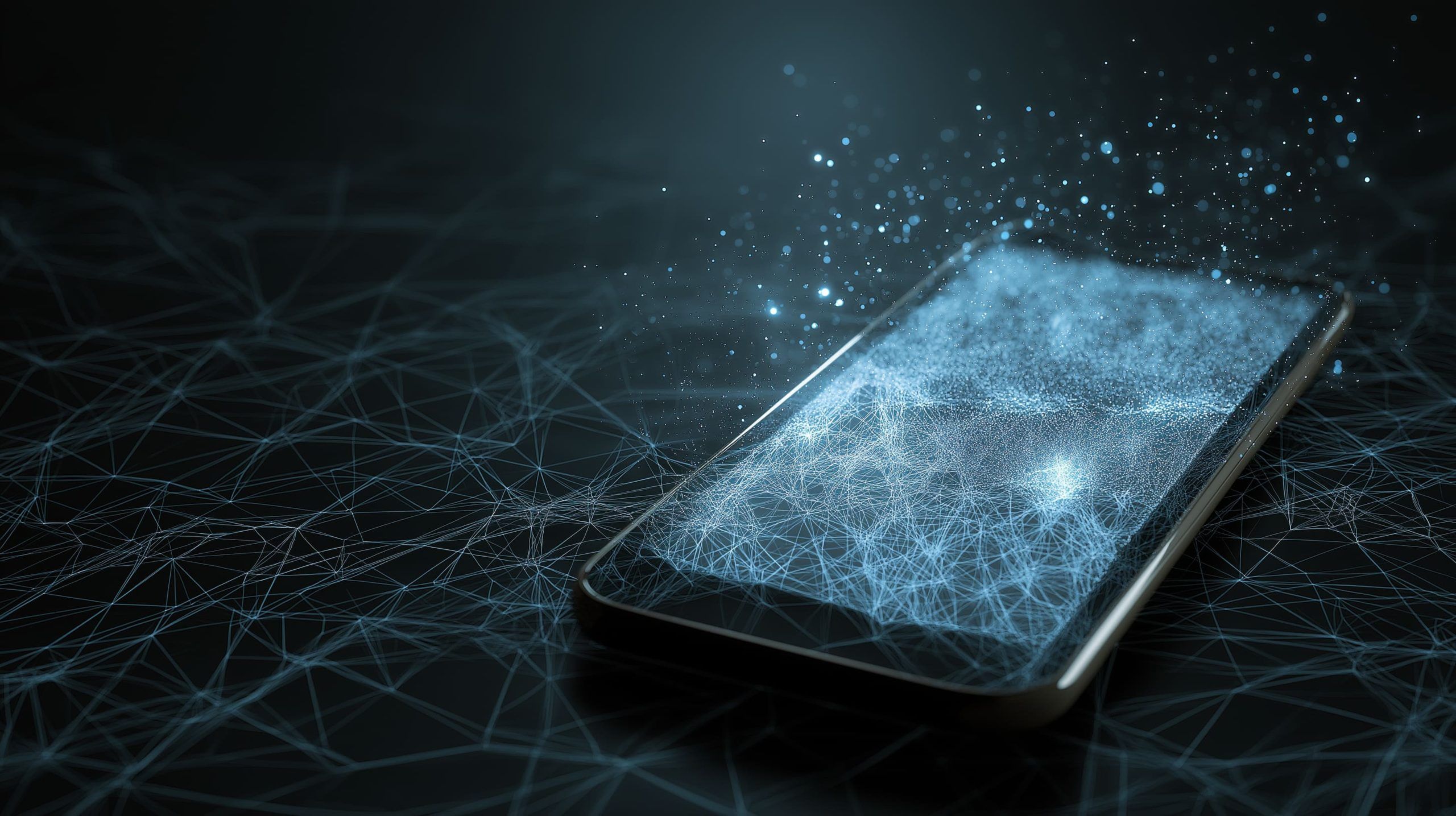- In 2022, Apple’s iPhone 14 introduced Emergency SOS via satellite, later expanded in the iPhone 15 to support satellite texting via Globalstar.
- In April 2023, AST SpaceMobile’s BlueWalker 3 demonstrated a two-way 4G call using a standard smartphone on Earth with a 64 m² satellite antenna.
- Lynk Global demonstrated the first direct satellite text to an unmodified phone in 2022 and is partnering with mobile operators in over 40 countries to fill coverage dead zones.
- SpaceX’s Starlink Direct to Cell uses 2023-generation satellites with advanced antennas to connect to ordinary phones via terrestrial bands, with a plan to offer basic text messaging across the U.S. by 2024 through a partnership with T-Mobile.
- Huawei’s Mate 60 Pro, released in late 2023, became the world’s first phone to support direct satellite voice calls using Tiantong-1 GEO satellites alongside BeiDou.
- In 2023 Qualcomm announced Snapdragon Satellite, enabling two-way satellite texting on Android phones via Iridium’s global LEO network.
- CAT S75 and Motorola Defy, released in 2023, adopted MediaTek’s NTN chipset (MT6825) to enable two-way satellite messaging on rugged handsets.
- Bullitt Group’s Motorola Defy Satellite Link, launched in 2023, is a pocket-sized Bluetooth accessory with its own GEO satellite transceiver that lets any phone send and receive texts for about $5 per month.
- Iridium Certus now offers data speeds up to approximately 700 kbps on portable terminals, while the Iridium GO! exec released in 2023 provides about 88 kbps internet via satellite.
- Deloitte forecasts over 200 million satellite-capable smartphones will be sold in 2024, representing roughly 15% of new phones globally.
Introduction: A New Era of Anywhere Connectivity
Imagine being able to send a message or make a call from anywhere on Earth, even far outside cellular coverage. That’s the promise driving the development of next-generation handheld satellite phones and advanced antennas. Long seen as bulky gadgets of last resort, satellite phones are now undergoing a revolution. Tech giants, satellite operators, and startups are racing to integrate space-based links into ordinary smartphones and rugged devices alike [1] [2]. The result? Handsets that seamlessly tap satellites when terrestrial networks vanish, miniaturized antennas that fit in pockets, and a wave of innovations that could make “no signal” a thing of the past. This report dives into the latest breakthroughs in satellite phone technology, the key players behind them, technical hurdles being overcome, emerging use cases from disaster response to remote exploration, and what the future holds for truly global connectivity.
Latest Innovations in Handheld Satellite Tech
Satellite communication is shedding its old limitations through bold new innovations in both devices and infrastructure:
- Satellite-Enabled Smartphones: Perhaps the most game-changing trend is the integration of satellite messaging into mainstream phones. In 2022, Apple’s iPhone 14 introduced an Emergency SOS via satellite feature, allowing users in remote areas to point their phone skyward and send a distress text via the Globalstar satellite network [3] [4]. This functionality – now expanded in the iPhone 15 – has already saved lives by enabling stranded hikers and motorists to contact emergency services with no cell signal [5] [6]. Hot on Apple’s heels, other manufacturers followed. In early 2023, Qualcomm announced Snapdragon Satellite, a partnership with Iridium to embed two-way satellite texting capability into premium Android phones [7]. Upcoming rugged phones like the CAT S75 and Motorola Defy 2 adopted this tech, letting users send regular messages via satellite for a fee, not just emergencies [8]. Even Huawei jumped in – its flagship Mate 60 Pro (late 2023) became the world’s first phone to support direct satellite voice calls (using China’s Tiantong-1 GEO satellites) alongside satellite SMS [9]. In short, the line between “satellite phone” and “smartphone” is blurring as everyday devices gain satellite links for off-grid communication [10].
- “Cell Towers in Space” Constellations: At the same time, a new breed of satellite networks is emerging to connect unmodified phones directly. In April 2023, AST SpaceMobile’s test satellite BlueWalker 3 made headlines by completing a two-way 4G phone call using a standard smartphone on Earth – essentially acting as a space-based cell tower [11] [12]. AST’s approach employs huge phased-array antennas in Low Earth Orbit (LEO) on 64 m² satellites to link with normal 4G/5G phones on the ground [13]. Similarly, startup Lynk Global has launched small LEO satellites that broadcast to regular phones, which see the satellite as a roaming cell signal [14]. Lynk demonstrated the first direct satellite text to an unmodified phone in 2022 and is partnering with mobile operators in over 40 countries to fill in coverage “dead zones” [15] [16]. And not to be outdone, SpaceX’s Starlink constellation (known for broadband) is adding “Direct to Cell” capability: their next-gen satellites launched in 2023 carry advanced antennas to connect to everyday phones using terrestrial mobile bands [17]. Starlink’s plan (in collaboration with T-Mobile) is to start offering basic text messaging across the U.S. by ~2024, with voice and data to follow [18] [19]. These projects represent a radical innovation – instead of requiring a specialized device with a big antenna, they put powerful antennas on satellites and leverage standard cellular protocols so that any phone could reach orbit. While still in early stages, these direct-to-device constellations are proving the concept that satellites can act as floating cell towers, closing gaps in coverage for the masses [20] [21].
- Advanced Antenna and Network Tech: Fundamental tech advances underpinning next-gen sat phones include better antennas and waveforms both in space and on earth. LEO satellites now use sophisticated beamforming antennas to focus signals and track moving phones [22]. For example, SpaceX’s v2 mini satellites and AST’s BlueBird satellites carry larger, high-gain antenna arrays to compensate for the tiny antennas in phones [23] [24]. On the device side, engineers are squeezing more performance out of small form factors – from optimized patch antennas in phones (aided by software that guides users to aim phones at satellites) to new external accessories. In 2023, Bullitt Group launched the Motorola Defy Satellite Link, a pocket-sized Bluetooth gadget that contains its own satellite transceiver and mini antenna. When paired with any smartphone, it allows you to send/receive texts via GEO satellites (using Inmarsat/EchoStar) for as little as $5/month [25] [26]. This “bring your own connectivity” approach lets people carry a slim module for off-grid messaging rather than a whole separate phone. Meanwhile, higher bandwidth systems are emerging. Iridium’s new Certus service piggybacks on its upgraded satellite constellation to deliver data speeds up to ~700 kbps (hundreds of times the old 2.4 kbps of legacy handsets) using portable terminals [27] [28]. They even released the Iridium GO! exec in 2023 – a briefcase-sized Wi-Fi hotspot that offers ~88 kbps internet and app access via satellite, a huge jump in portable capability [29]. In short, from chipsets to constellations, next-gen tech is boosting satellite phone performance while shrinking equipment size, heralding a new era of truly mobile, always-connected communication.
Key Players Driving the Satellite Phone Revolution
Developing and deploying next-generation satellite phone technology is a team effort spanning industries. Here are the key players and companies propelling these advancements:
- Traditional Satellite Operators (Iridium, Inmarsat, Globalstar, Thuraya): The established satphone network providers are modernizing their fleets and services. Iridium Communications completed its $3B NEXT LEO constellation upgrade, ensuring truly global coverage and enabling new services like Iridium Certus broadband [30] [31]. Iridium still serves ~400,000 subscribers (voice, data, IoT) as of end-2022 [32], and it’s partnering with smartphone chipmakers (Qualcomm) to extend its reach into consumer devices [33]. Inmarsat (now part of Viasat) operates GEO satellites for services like the IsatPhone 2 and BGAN terminals; it’s launching next-gen I-6 and planned I-8 satellites with advanced L-band and Ka-band payloads to boost capacity through the 2040s [34] [35]. Thuraya (Yahsat’s mobile arm) covers Europe, Africa, Middle East, and parts of Asia with two GEO satellites; a new Thuraya-4 NGS satellite is under construction to expand coverage in 2024 [36]. Thuraya also pioneered the first Android satphone (X5-Touch) and is planning hybrid devices like the Thuraya WE (a Wi-Fi hotspot + satphone) to attract broader users [37]. Globalstar, which runs a 48-satellite LEO network, received a major boost from Apple’s investment of $450M to secure 85% of its network capacity [38]. Globalstar is using that funding to launch new satellites later this decade and support Apple’s iPhone services [39] [40]. While its current voice handset (GSP-1700) is dated, Globalstar’s focus is shifting to partnerships (like Apple and IoT tracking) to leverage its network [41]. All four operators remain crucial players, maintaining the infrastructure that dedicated sat phones rely on, even as they adapt to a more connected world.
- Smartphone Makers and Big Tech (Apple, Huawei, Android OEMs): Consumer technology giants have become unlikely drivers of satellite phone innovation. Apple grabbed headlines by integrating satellite SOS into millions of iPhones, instantly creating a user base for satellite services [42] [43]. Apple’s deal with Globalstar not only enabled the service in 14 countries but is also funding a new generation of satellites to support future iPhones [44]. The appeal for Apple (and its competitors) is clear: adding safety connectivity is a selling point encouraging users to upgrade phones [45]. Huawei, on the other side of the world, achieved a first with the Mate 60 Pro, which supports satellite voice calls and SMS via China’s Tiantong-1 and BeiDou systems [46]. This effectively puts satphone capability in a mainstream handset for the Chinese market, highlighting how national programs can leapfrog in this area. Meanwhile, Android OEMs like Motorola (via Bullitt Group) and CAT have released models in 2023 with built-in satellite messaging using MediaTek’s new NTN (Non-Terrestrial Network) chipset [47]. Even Samsung and others are rumored to be exploring satellite features as the technology matures. In short, big tech is embracing satellite links as the next frontier in mobile features, dramatically expanding the ecosystem of devices that can connect off-grid.
- New Space Ventures & Mobile Carriers (SpaceX, AST SpaceMobile, Lynk, T-Mobile & others): A wave of well-funded startups and projects is working to blend satellite and cellular connectivity into one seamless service. AST SpaceMobile has attracted investments from carriers like AT&T, Vodafone, Telefónica and tech giants like Google [48]. Its plan: deploy 100+ large LEO satellites that function as space-based cell towers, directly handling 5G phone calls and data [49] [50]. AST’s April 2023 tests already proved a standard 5G phone call via satellite, and initial commercial satellites are slated to launch by 2024–25 [51] [52]. Lynk Global, a smaller startup, is pursuing a “cell tower in a shoebox” approach with nanosatellites. Lynk sent the first satellite SMS to a normal phone in 2022 and aims to scale to hundreds of satellites, working directly with local mobile operators so a phone will roam onto “Lynk” when no towers are around [53] [54]. They’ve secured regulatory approvals for emergency texting in two dozen countries and plan to cover island nations like Palau first [55] [56]. On the established side, SpaceX in partnership with T-Mobile is leveraging Starlink: by using T-Mobile’s existing PCS spectrum from orbit, they plan to let ordinary subscribers text via Starlink satellites without any new hardware [57] [58]. The ambition is full global text coverage after 2024 and eventually voice/data as technology improves [59]. Other mobile network operators are also signing on – for instance, operators in New Zealand and Switzerland have deals with SpaceX, and others likely to follow [60]. These collaborations between satellite ventures and telcos are bridging two industries, with each side bringing expertise (satellite tech vs. customer service & billing, spectrum rights) to make direct-to-phone satellite service a reality. If successful, they could massively expand the reach of mobile networks worldwide.
- Semiconductor and Tech Enablers (Qualcomm, MediaTek, Garmin, Others): Underlying much of this progress are the companies providing the chips, modules, and services to make satellite connectivity feasible in small devices. Qualcomm introduced satellite messaging support in its Snapdragon 8 Gen 2 mobile chipset, effectively allowing any phone maker using that chip to offer two-way satellite SMS and beyond [61]. This was done in partnership with Iridium, leveraging Iridium’s truly global LEO network so that Android phones can send texts from pole to pole [62]. Rival MediaTek developed its MT6825 NTN chipset, used by Bullitt in the CAT S75 and Motorola Defy, to communicate with Geosynchronous satellites for store-and-forward messaging [63]. These chip innovations are critical – they handle the specialized waveforms and signal processing required to talk to satellites, all while fitting in a phone’s power and size constraints. On the services side, companies like Garmin have long been at it, providing satellite communicators (inReach devices) and running emergency response centers that now even assist smartphone SOS features [64]. Garmin’s inReach, SPOT, ZOLEO and others paved the way in popularizing personal satellite messengers – compact gadgets for hikers to text and SOS via satellite [65] [66]. Their success (hundreds of thousands of backcountry users) signaled to the industry that there is a mass market appetite for off-grid connectivity, beyond just militaries and mariners [67] [68]. Also in the mix are antenna designers (working on flat, phased, or multiband antennas) and network standards bodies like 3GPP, which in Release 17 of the 5G standard introduced specifications for satellite “NTN” support [69]. All these players – big and small – form a growing ecosystem making satellite comm not only possible but user-friendly.
Major Technical Challenges (and How They’re Being Overcome)
Designing phones and networks that talk to satellites presents formidable technical challenges. Here are the primary hurdles and the approaches being taken to address them:
- Distance and Signal Strength: Communicating with a satellite hundreds or thousands of kilometers away is inherently harder than reaching a cell tower a few miles away. The satellite signal path incurs large free-space loss and delay, and handheld devices have limited transmission power and small antennas. Traditionally, this meant sat phones needed chunky external antennas (15–20 cm stub or fold-out panels) and very clear line-of-sight to the sky to work [70] [71]. To overcome this, next-gen systems attack the problem from both ends: improve the satellite and improve the phone. On the satellite side, companies are deploying spacecraft with much larger, more sensitive antennas and high-power transmitters so they can pick up faint handset signals and beam stronger ones down [72] [73]. For example, AST SpaceMobile’s prototype has the largest commercial antenna ever in low orbit (64 m²), essentially compensating for a phone’s tiny antenna by making the satellite do the heavy lifting [74]. On the device side, new antennas and RF (radio) components are being optimized within the tight space and battery constraints. Phones like the iPhone 14 use a special patch antenna and custom radio that activates for satellite mode [75] [76]. Users are guided via on-screen prompts to point the phone toward the satellite to maximize signal – a clever software solution to effectively create directionality without a large antenna. Accessories like the Bullitt/Motorola Defy Link include a dedicated ceramic patch antenna tuned for satellites, but offload the processing to your smartphone via Bluetooth. In essence, the challenge of distance is being met with better link budgets – bigger space antennas, smarter device antennas, and leveraging techniques like beamforming to focus energy where it’s needed [77].
- Moving Targets and Intermittent Coverage: Unlike fixed cell towers, many next-gen satellites orbit at very high speeds. A LEO satellite can streak across the sky in minutes, meaning a phone only has a short window to connect before handing off to another satellite. Ensuring a continuous connection as satellites come and go is a complex task. Older satphone systems mitigated this by having constellations of dozens of satellites (e.g. Iridium’s 66 satellites) so that at least one is always in view and another comes over the horizon as one sets [78] [79]. Modern direct-to-phone services will similarly need dense constellations – AST SpaceMobile estimates 110 satellites for global coverage, while Lynk targets over 1,000 for robust service [80] [81]. The handoff process itself (switching a connection from one satellite to the next) is far trickier than cell tower handoffs because it involves fast-moving objects and significant Doppler shift. To tackle this, companies are leveraging standard cellular protocols (like 4G/5G) adapted for timing and Doppler in space, effectively making the satellite appear as just another “tower” to the phone [82] [83]. Beamforming technology allows a single satellite to digitally steer multiple beams and track many phones at once, even as it moves [84]. For example, Starlink’s satellites will use agile beamforming so they can link to phones over a wide area during their pass [85] [86]. Still, intermittent connectivity is a reality – initial direct-to-phone offerings are store-and-forward (a text might wait for the next satellite pass if one isn’t currently overhead). Over time, as constellations fill out, those gaps will narrow. In sum, the challenge of a moving network is being addressed by sheer numbers of satellites and advanced networking that coordinates hand-offs in fractions of a second.
- Limited Bandwidth and Latency: Traditional handheld sat phones offered very slow data speeds (as low as 2.4 kbps) and noticeable voice lag, due to narrowband channels and (for GEO systems) long signal travel times [87]. This is a major technical barrier to making satellite connectivity feel “like normal.” Next-gen systems are making progress here too. New LEO constellations virtually eliminate the latency problem – LEO satellites are much closer (500–1500 km up vs 36,000 km for GEO), reducing round-trip delay to the order of 50–100 milliseconds, almost on par with terrestrial networks. The bigger issue is bandwidth: satellites can only handle so much traffic, and spectrum is limited. Techniques to boost throughput include using wider frequency bands or higher frequencies (e.g., Inmarsat’s new I-6 satellites carry Ka-band payloads for high-speed links [88]), employing advanced coding/modulation to pack more bits into each transmission, and dynamic beam allocation to reuse frequencies over different areas. Network-on-the-edge architectures are also being explored, where satellites might process or route data intelligently to optimize limited links [89]. Despite these advances, initial direct-to-phone services will be very narrowband. For instance, SpaceX noted that a single cell on their satellite might only support “2–4 Mbps shared across a large area,” which could equate to just a handful of voice calls or a few thousand text messages at once [90]. This is why early offerings focus on low-bandwidth use (texting, emergency signals) rather than streaming video. Over time, constellation capacity will grow – through more satellites, inter-satellite laser links to route traffic efficiently, and perhaps integrating satellites as an extension of 5G networks for things like NB-IoT (narrowband IoT) which only needs tiny bursts of data [91] [92]. The technical challenge is clear: how to deliver acceptable data rates from space without giant user antennas or burning through battery – and it’s being gradually solved by better satellite technology and clever network design, albeit with the understanding that satellite links will complement, not replace, terrestrial broadband for the foreseeable future [93].
- Power and Battery Life Constraints: Maintaining a link to space can be power-intensive for a handheld device. Transmitting a signal to a satellite requires significantly more RF power than to a nearby cell tower. This raises concerns about battery drain and device heating when using satellite mode. Manufacturers are mitigating this in a few ways. First, the use of bursty, short-duration communications – primarily text messages or quick SOS bursts – limits how long the radio needs to transmit at high power, preserving battery. Apple’s implementation, for example, only activates the satellite modem during an emergency texting session, and messages are optimized for brevity. Second, improved radio efficiency and power amplifiers are employed in new chipsets to maximize range per watt. The Qualcomm Snapdragon Satellite system leverages efficient L-band spectrum and low-data-rate protocols that don’t require continuous transmission [94] [95]. Additionally, dedicated satellite gadgets are boasting better battery performance: e.g. the Garmin inReach Messenger – essentially a satellite texting device – can last up to 28 days on a charge by intermittently checking for messages rather than staying on a live link [96] [97]. Solar charging accessories are also popular in expedition use to keep sat gadgets topped up. In essence, while satellite comm will always consume more power than normal cell use, careful duty cycling, optimized hardware, and user behavior (using it only when needed) help manage this challenge. Future devices might also use adaptive power control – only using full power when the satellite link truly requires it, and backing off when a strong link is available (say, satellite overhead with clear skies).
- Integration and Interoperability: Another challenge is making satellite connectivity seamlessly interoperable with terrestrial networks. Ideally, a user’s phone would automatically switch to satellite mode when you leave coverage, then switch back when you’re in range of a tower – all without manual intervention or drops. Achieving this requires coordination between satellite service providers, device manufacturers, and cellular carriers. Progress is being made via standards: the 3GPP Release 17 (completed in 2022) added initial standards for Non-Terrestrial Networks (NTN), defining how 5G devices and satellites can communicate and how networks might hand off between Earth and space [98]. Down the line, a 5G phone could treat a satellite just like another cell in the network. Some companies are pursuing a more proprietary route in the interim (e.g., Apple’s solution is currently Apple-specific and emergency-only). Interoperability also implies regulatory and spectrum alignment – ensuring a phone can legally and technically use a given frequency band via satellite in whatever country it’s in. Efforts like the FCC’s recent proposed framework in the U.S. aim to simplify collaborations by letting satellite operators lease spectrum from mobile operators for space-based service [99]. This way, a phone can use the same frequency band whether connecting to a terrestrial tower or that carrier’s partner satellite, avoiding complex multi-band juggling. Though there’s more to do, especially for global roaming across different systems, the industry is steadily moving toward an integrated network-of-networks. The vision is a handset that roams freely between cell and satellite, and even between different satellite constellations, much as it would between cell networks abroad. Solving this will involve further standards work (3GPP Release 18+ will enhance NTN features) and business agreements, but the technical groundwork is being laid now to make interoperability a reality [100] [101].
Emerging Use Cases for Next-Gen Satellite Phones
The improving capabilities and accessibility of satellite phones are unlocking new and expanded use cases across various domains. Some key applications and scenarios include:
- Disaster Response and Emergency Rescue: In natural disasters or wide-scale outages, satellite phones become lifelines when regular networks fail. Next-gen sat phones are poised to enhance disaster communications for first responders and affected populations. For example, Apple’s Emergency SOS via satellite has already enabled rescues in remote emergencies like car crashes in areas with no cell coverage [102] [103]. Relief agencies increasingly deploy satphones to coordinate after hurricanes and earthquakes, and the newer devices (with easier texting and location sharing) will improve situational awareness. The fact that satellite SOS is now built into consumer phones means anyone can call for help from the wilderness or disaster zone, a major boon for public safety. As these services expand, we can expect emergency call centers and 911 systems to integrate satellite-originated calls/messages more seamlessly.
- Remote Communities and Connectivity for All: Despite global cellular expansion, roughly 400 million people still live outside mobile broadband coverage [104]. Next-gen satellite networks offer a chance to shrink this digital divide. Small island communities, mountainous villages, or nomadic populations could gain basic connectivity (like texting or WhatsApp messaging via satellite) without waiting for expensive tower infrastructure. While cost and device access remain challenges for the poorest regions, ongoing efforts by companies and NGOs might subsidize satellite messaging for critical communications in underserved areas. Even in developed countries, communities on distant islands, deep in the outback, or in Alaska’s far north could see their local connectivity improved by satellites, whether through community hubs or personal devices. The overarching humanitarian vision is that no person should be unreachable, no matter how remote their location, and satellite advancements are a key enabler of that [105].
- Military, Security, and Disaster Relief Operations: Government and military users have long relied on satellite communications, and next-gen tech will further enhance their capabilities. Armed forces will benefit from smaller, more portable satcom gear for troops – for instance, a special forces unit could carry rugged smartphones that automatically swap to sat mode when out of range, maintaining encrypted comms beyond front lines. Push-to-talk group communications over satellite are already offered (e.g. Iridium’s PTT service on the 9575A handset) for coordinating units in the field [106]. With the advent of direct-to-phone satellites, even standard issue phones could have backup connectivity in conflict zones where infrastructure is knocked out. Disaster relief teams and NGOs responding in areas with wiped-out comms (like a post-earthquake region) similarly stand to gain – they can use readily available phones or small hotspots to get critical connectivity without hauling as much specialized gear. The ruggedness and reliability of traditional sat phones (many are built to military specs) combined with easier connectivity will ensure these remain staples for safety and security-focused users.
- Maritime and Aviation Communications: Satellite phones and terminals are indispensable at sea and in the air, where no cell towers exist. Every ship that ventures beyond coastal waters – from fishing boats to cargo ships and private yachts – carries some form of satcom for safety. New handheld sat phones with better battery life and features are useful for mariners (e.g. the popular Inmarsat IsatPhone 2 offers ~8 hours talk and 160 hours standby, crucial for long voyages) [107]. For ocean racing and offshore sailing, lightweight sat phones and external marine antennas (often required by race rules) let crews stay in touch or call for help anywhere [108] [109]. On the aviation side, small aircraft and private pilots are starting to use satellite messengers and phones for flight following and emergency contact when flying over remote areas. There are satphone kits that wire into a cockpit with a window-mounted antenna, allowing calls from the sky [110] [111]. Looking ahead, the ability for a pilot’s normal smartphone or a plane’s onboard cellular system to link to satellites (as Lynk and others are testing) could provide continuous connectivity for telemetry and communication even on transoceanic or polar routes. This adds a layer of safety and convenience for aviation, ensuring that even high above the Earth, you’re never truly out of reach.
- Outdoor Recreation and Adventure Travel: Hikers, climbers, explorers, and extreme sports enthusiasts are increasingly packing satellite communicators on their trips – a trend that will only grow with newer options. Adventure tourism is on the rise, and whether it’s a trek in the Himalayas, an Amazon expedition, or an overlanding journey in the Sahara, having a compact satellite link offers peace of mind. Devices like Garmin inReach, ZOLEO, or SPOT allow two-way messaging so adventurers can stay in touch or call for rescue, and many guide companies now require clients to carry one [112] [113]. Next-gen sat phone tech will make this even more appealing by reducing device size and cost. The Motorola Defy Satellite Link accessory, for instance, is a $99 gadget that anyone can add to their smartphone before going off-grid, instead of buying a $1000 sat phone. As satellite connectivity becomes a common smartphone feature, we may soon see popular hiking and navigation apps integrating satellite messaging, so your topo map app can send a check-in message via satellite if no cellular is available. In essence, the outdoors community is embracing satellite tools as standard safety gear, and the improved accessibility of next-gen solutions will cement that trend.
- Scientific Expeditions and Remote Industry: Researchers working in polar regions, deep rainforests, or out on research vessels have historically been heavy satphone users – for coordinating logistics or transmitting data from the field. The new generation of equipment (like portable broadband hotspots and higher-data-rate terminals) will greatly aid science teams. For example, an Antarctic expedition could use an Iridium Certus device to send back photos or sensor readings in near real-time – something not feasible with older 2.4 kbps links. Industries such as mining, oil & gas, and forestry, which operate in remote hinterlands, also stand to benefit. They can deploy hybrid cellular-satellite solutions for their crews: workers’ phones might use regular LTE around a base camp (if a temporary cell is installed) but automatically switch to satellite as they go farther out. Internet of Things (IoT) use cases in these sectors are significant too – pipelines, weather stations, or wildlife trackers in remote areas already use satellite links for data, and with upcoming satellite IoT standards (Iridium’s “Project Stardust” aims for direct IoT-device to satellite 5G links by 2026 [114]), this will expand. Handheld sat phones may double as hubs for IoT sensors in the field, collecting data via Bluetooth and uploading via satellite. The common theme is ubiquitous connectivity for work in remote areas, improving efficiency and safety for science and industry.
In all these scenarios, next-gen satellite phones and services are expanding the reach of communications. They ensure that critical connectivity – whether for saving lives, conducting business, or simply staying in touch – isn’t confined by geography. As devices become more user-friendly and affordable, expect to see satellite links quietly working behind the scenes in everything from your car’s emergency system to your hiking gear.
Trends: Miniaturization, Power Efficiency, and Network Integration
Several important technology trends are shaping the evolution of handheld satellite phones and their antennas:
- Shrinking Form Factors: Early satellite phones were infamous for their brick-like size and protruding antennas – essentially 1980s-style cell phones on steroids [115]. Today, thanks to advances in electronics and antenna design, modern handheld sat phones are far more compact and ergonomic. Some current models are not much larger than a regular smartphone [116], despite containing satellite radios and high-capacity batteries. The Thuraya X5-Touch, for example, is an Android smartphone with a touchscreen and only a small stub antenna, a far cry from the old “cinder block” phones. The trend of miniaturization extends to accessories too: the newest satellite hotspot devices (like Iridium GO! exec, some Thuraya hotpots, etc.) are smaller and lighter, meant to slip into a backpack. Antenna miniaturization is a tougher nut to crack (physics dictates that gaining signal strength usually needs size), but engineers are employing clever tricks: fold-out antennas that pack small, high-gain patch antennas that use device casing as ground planes, and even experimental metamaterial antennas that could one day flatten into the device body. The integration of satellite capability into standard smartphones is the ultimate miniaturization – using the phone’s existing housing and only adding chips, not bulk. We’re seeing the first examples of that now (iPhone, CAT S75), and more are expected as chipsets like Qualcomm’s become mainstream. In summary, every generation is getting smaller and lighter, making satellite comms less of a burden to carry.
- Improved Battery Life & Power Management: Running satellite communications on a handheld used to mean very short talk times (e.g. 30 minutes to a couple hours) because of the power needed. This has improved markedly. For instance, the Inmarsat IsatPhone 2 boasts 8 hours of talk or 160 hours standby on a charge, reflecting both a large battery and efficient power use [117]. Device manufacturers are optimizing firmware so that the satellite modem is in use only when absolutely necessary, and otherwise sits in low-power idle. Many sat devices now also offer power-saving modes, like only listening for incoming messages every X minutes to extend battery life when on standby. The use of low-data-rate messaging (as opposed to continuous voice) also inherently conserves energy – a quick text uses only a burst of transmission. Furthermore, as mentioned, specialized chips from Qualcomm and MediaTek are designed to handle satellite links with minimal power overhead, benefiting from modern semiconductor efficiencies. We also see trends like solar integration (some satellite messengers come with optional solar panels or cases) and cross-charging (the Garmin inReach Messenger can reverse-charge a phone in a pinch [118] [119]). All told, next-gen satphones are far more power-efficient, ensuring that critical connectivity lasts longer in the field.
- Hybrid Connectivity and Seamless Handoffs: A major trend is the blending of satellite and terrestrial connectivity into a unified user experience. The term “hybrid satellite-cellular” is increasingly used to describe devices or services that use both, depending on what’s available [120] [121]. Dual-mode phones (like Thuraya’s) have been around for a while, but what’s new is the prospect of seamless switching without user intervention. Industry efforts like 3GPP’s NTN standard and carrier-satellite partnerships are driving this. In practical terms, this could mean your phone stays on “5G” indicator, but that 5G might be coming from a satellite when you’re off-grid – and you might not even notice beyond perhaps a slight slowdown. Already, Lynk Global’s system is designed so a phone simply thinks it’s roaming on a partner network when it connects to a satellite [122]. In the near future, we’ll likely see roaming agreements between terrestrial and satellite networks such that consumers don’t have to manage separate subscriptions. Apple’s approach so far has been free emergency use; T-Mobile suggests its satellite texting will be included for subscribers on plans [123]. This bundling would encourage usage as part of normal connectivity. Interoperability is another facet: ensuring devices from different makers and different satellites can all interconnect. Stakeholders are discussing global standards for interoperability and security in satellite-direct devices [124] so that, for example, an emergency SOS from any phone can be handled reliably by any satellite system in range. The long-term trend is clear – connectivity is becoming “agnostic” to the platform, aiming to handoff between Wi-Fi, cellular, and satellite as needed to keep you connected at all times [125] [126].
- Cost Reduction and Accessibility: Historically, satellite phones have been very expensive (often $1000+ for a handset and $1 per minute or more for calls). A significant trend is driving down the cost and lowering barriers to entry. Market competition and new tech are helping: the Globalstar GSP-1700 satphone, for example, can sometimes be found for a few hundred dollars (as it’s older) [127] [128], and service plans have come down a bit or become more flexible (some providers offer prepaid or short-term plans for occasional use [129]). More impactfully, new entrants like Starlink’s planned service could pressure incumbents to offer more competitive pricing (Starlink hinted at no extra charge for emergency use, and modest fees for general use) [130]. Also, the involvement of consumer tech companies means subsidized models: Apple provides two years free SOS service with new iPhones [131], effectively eating the cost to get users on board. As satellite messaging becomes a more normal feature, economies of scale could kick in – Deloitte predicts over 200 million satellite-capable smartphones will be sold in 2024 alone [132], containing about $2B worth of satellite tech, which suggests component costs will drop with volume. We’re already seeing “satellite for everyone” approaches like the $5/month plans for 30 satellite messages (Bullitt’s service) [133], which are unprecedentedly low prices in this sector. While top-tier satphones and unlimited plans will remain pricey for heavy users, the general trend is a broadening user base through more affordable options, making satellite connectivity less of an elite, last-resort product and more a mainstream safety net.
- Spectrum and Regulatory Evolution: On the technical policy front, there’s a trend of regulators adapting to the new hybrid reality. Spectrum that was once exclusively for mobile or for satellite is being reconsidered for shared use. The FCC’s 2023 proposal to allow satellites to use licensed cellular bands via partnerships is one example [134]. Similar conversations are happening globally, as regulators see the value in allowing non-terrestrial networks to complement coverage. There’s also movement towards streamlined landing rights (the permission for a satellite service to operate in a given country). If half the phones sold start having satellite capability, countries will face pressure to allow at least emergency use of those functions even if sat phones were previously banned (as they are today in places like India or North Korea) [135] [136]. We may witness an era of international agreements focusing on satellite SOS and humanitarian use, ensuring travelers aren’t jailed for carrying a satellite device needed for safety [137]. Technically, this trend ensures that the airwaves remain organized and interference minimized as more satellites and devices communicate – expect ongoing work in ITU (International Telecommunication Union) forums to coordinate frequencies for these new services. All told, the trajectory is towards more flexible use of spectrum and harmonized regulations to accommodate the boom in satellite-direct communications.
Regulatory and Spectrum Considerations
The convergence of satellite and cellular communications raises important regulatory and spectrum issues that are actively being addressed:
- Spectrum Allocation and Sharing: Satellite phone systems historically use distinct frequency bands (e.g., L-band around 1.5–1.6 GHz for Iridium, Thuraya, Inmarsat; S-band for some uplinks; etc.). Now, with projects like AST and Starlink planning to use existing mobile network bands from space, regulators must figure out how to permit shared use without harmful interference. In the U.S., the FCC has proposed a new regulatory framework to enable such collaborations [138]. Under this plan, a satellite operator can apply to use spectrum already licensed to a terrestrial carrier, effectively partnering with that carrier (like T-Mobile with SpaceX) to provide service from orbit [139]. This is a big policy shift, as previously satellite and cellular were siloed domains. Similar initiatives are underway in other regions, often referred to as enabling “supplemental coverage from space.” Regulators need to ensure that when a satellite beams into a frequency normally used by ground towers, it doesn’t interfere with those ground networks (this involves technical coordination like only using the spectrum in areas or times the terrestrial network is absent, and limiting power levels). International coordination is crucial too: satellites footprint many countries, so agreements at the ITU level and between national agencies will dictate how global these services can be. The trend is toward allowing more flexible use of spectrum to maximize coverage – a delicate balancing act that regulatory bodies are carefully managing.
- Country Restrictions and Authorizations: Another consideration is that satellite communication services must typically be authorized on a country-by-country basis. Landing rights (permission for the satellite signals to be delivered to users in a country) and usage permissions for devices can vary widely. Notably, some countries ban private satellite phones or require special permits, often citing security concerns (they don’t want unmonitorable communications) [140]. India, for example, forbids unregistered satphones and has detained unwitting tourists carrying them [141]. As satellite connectivity becomes embedded in regular smartphones, this stance may be forced to evolve. It’s impractical to ban millions of smartphones just because they have an SOS feature. We may see countries like India updating policies to allow limited use (e.g., only emergency SOS via approved services) so that they maintain security while not endangering travelers. Licensing of service providers is another aspect – companies like Lynk or AST will need to get telecom licenses in each country or partner with local mobile operators who have licenses. That process is ongoing: Lynk, for instance, has garnered testing licenses or MOUs in several countries already [142]. Governments will likely impose conditions like the satellite service adhering to lawful interception requirements or providing access to location info for emergencies. The regulatory landscape is therefore in flux: generally opening up, but with each nation imposing its own flavor of oversight.
- Safety and Emergency Mandates: Regulators and international bodies are also looking at how satellite capabilities can improve safety and how to integrate that into official frameworks. For example, global maritime and aviation authorities (IMO and ICAO) have long required certain satellite equipment on ships (EPIRBs, etc.) and planes. With new systems, they might approve next-gen devices for meeting safety requirements (e.g., a satellite-equipped broadband unit for continuous aircraft tracking, post-MH370). On the consumer side, emergency services in multiple countries are updating their systems to handle satellite 911 calls or texts. There are discussions about ensuring satellite SOS messages are routed correctly to local rescuers – companies like Apple have set up relay centers for this, but long-term a direct integration into emergency dispatch might be preferable [143]. Some regions might mandate that if a phone has satellite SOS, it must meet certain reliability criteria or provide free access. Privacy and security are part of the conversation too: satellite networks, especially if widely used, must ensure data security (3GPP’s standards are looking at satellite link encryption and authentication to be on par with cellular). There’s also orbital regulation: launching hundreds or thousands of new satellites triggers concerns about space debris and coordination (so satellite networks must file with regulators like FCC/ITU for orbital slots and follow debris mitigation rules). In short, regulation is adapting on multiple fronts – from spectrum sharing to service authorization to safety protocols – to both enable innovation and protect public interests as satellite phones enter the mainstream.
Future Outlook: What the Experts Predict
The coming years promise to be transformative for satellite-based connectivity. Industry experts and market analysts foresee significant developments, although opinions vary on the pace and scale:
- Mainstream Adoption of Satellite-Enabled Devices: Analysts predict an explosion in the availability of satellite-capable consumer devices. Deloitte, for instance, estimates that over 200 million smartphones sold in 2024 will be satellite-connectivity enabled, thanks to new chips and features [144]. This could mean roughly 15% of new phones globally have some satellite function, an astonishing uptake in a short time. As a result, by the late 2020s, it may be standard for phones to include basic satellite messaging as a checkbox feature (much like GPS or Wi-Fi). This doesn’t mean everyone will suddenly own a satphone plan, but the hardware capability being widespread is the first step. Wearables and vehicles might follow – imagine smartwatches sending emergency signals via satellite, or cars with built-in satellite SOS for when you drive out of coverage. The consensus is that satellite connectivity will increasingly be seen as a must-have backup, giving consumers extra peace of mind and mobile operators a way to reach beyond their current footprint [145] [146].
- New Revenue Streams vs. High Costs: From a business perspective, there’s both optimism and caution. Some stakeholders are bullish, envisioning a multi-billion-dollar new industry of direct-to-device satellite services within a decade [147]. They argue that people will pay a few extra dollars on their phone bill for the ability to text or call from anywhere, and enterprises and governments will invest heavily in these capabilities. However, others warn it may take time to mature and see returns, citing the immense capital expenditure of launching and maintaining satellite constellations [148]. Questions remain: Will enough consumers pay for beyond-emergency use? What pricing models will stick (subscription vs. pay-per-use)? And can the satellite operators sustain the deployment costs if uptake is slow? Companies like Lynk going public with ~$800M valuations and AST SpaceMobile attracting hundreds of millions in investment show investor belief in the opportunity [149]. But profitability will hinge on scale and partnerships. The likely scenario is a gradual ramp-up: initial services (mostly emergency/SOS) possibly subsidized or free, then upsell to premium messaging bundles, and eventually perhaps satellite data add-ons for remote workers, adventurers, or international travelers. If the market responds well, by 2030 we could see a thriving ecosystem where satellite connectivity adds significant revenue for mobile operators and satellite firms alike – effectively growing the pie of the global telecom market [150] [151].
- Technical Evolution and 5G/6G Integration: Technologists predict that technical hurdles will continue to be overcome, making satellite links more seamless. The integration with 5G networks is already underway (with Release 17 NTN, as noted). Looking further, experts see future standards (Release 18 and eventually 6G) deepening that integration – possibly allowing broadband service direct to phones with new modulation schemes, and coordinating satellite-terrestrial networks for load balancing. There’s speculation that 6G (around 2030) will treat non-terrestrial coverage as a core component, not an afterthought, enabling global connectivity as a built-in feature. In the nearer term, by the late 2020s, we might have “network selection” intelligence where your phone’s SIM can latch onto a partner satellite if your carrier has one, or even broker connectivity between multiple available satellite networks to get the best signal. On the device hardware front, we may see antenna innovation like deployable or steerable antennas in phones (some patents envision antenna elements that reconfigure to boost gain when needed). Phased-array antennas in miniaturized form could appear in specialized devices, allowing higher data rates or multi-satellite tracking. And more powerful battery tech (or lower-power chips) will aim to equalize the battery impact. Overall, experts believe technical advancements will steadily chip away at the current limitations, making the user experience closer to what we expect from normal mobile use – though it’s acknowledged that satellite will complement, not replace, terrestrial networks for high-bandwidth needs [152].
- Ubiquitous Connectivity and Societal Impact: The broader implication of next-gen satellite phones is a world where no location is off-grid. Futurists and telecom visionaries often talk about “connectivity like air”, meaning it’s just there, everywhere [153]. We are moving toward that reality. The direct benefit is enhancing safety (no one stranded unable to call for help) and connectivity (businesses and communities in remote areas get links to the world). Some experts highlight how this could enable new behaviors and innovations: for instance, adventure tourism could boom when people know they can stay connected; smart agriculture in developing countries could use IoT sensors because satellite links are accessible; or global humanitarian projects can be coordinated better in real-time. There’s also a potential societal shift – as connectivity reaches extreme rural and remote zones, it could improve education and economic inclusion for those populations. However, a note of caution is also sounded: making it technically possible doesn’t automatically ensure success or adoption [154]. Challenges like affordability, user awareness, and regulatory acceptance need to be managed. Experts stress that the industry must focus on keeping services reliable and costs reasonable while scaling up [155] [156]. If they succeed, the once-niche satellite phone will become an everyday utility, and being “out of reach” might truly become a thing of the past. As one industry researcher put it, the ultimate goal is “no person should be unreachable, no matter how remote” [157] – a vision that is now within reach (pun intended).
In summary, the development of next-gen handheld satellite phones and antennas is on a fast track. The coming years will likely bring greater device choices, improved performance, and deeper integration of satellite connectivity into our lives. While challenges remain (technical, economic, and regulatory), the momentum and multi-industry commitment make it clear that “always connected anywhere” is more than a slogan – it’s becoming reality.
Summary of Notable New Devices and Capabilities (2022–2025)
To wrap up, the table below highlights some of the notable new devices and solutions in the satellite phone space, along with their key specs and capabilities:
| Device (Launch) | Satellite Network / Tech | Key Capabilities | Notable Features |
|---|---|---|---|
| Apple iPhone 14/15 (2022/23) | Globalstar LEO network [158] | Emergency SOS texting (no voice) via satellite; location sharing to emergency services [159] [160] | First mass-market phones with built-in satellite messaging (free for 2 years; available in 14+ countries) [161]. |
| Huawei Mate 60 Pro (2023) | Tiantong-1 GEO & BeiDou (China) [162] | Two-way satellite voice calls and SMS built into phone [163] | World’s first smartphone to support direct satellite calling (China Telecom service; works only under Chinese coverage). |
| Snapdragon Satellite Phones (2023 onward) | Iridium LEO (Qualcomm Snapdragon 8 Gen 2 platform) [164] | Two-way messaging (SMS, messaging apps) via Iridium satellites, plus SOS alerting [165] [166] | Chipset solution enabling multiple new Android phones (e.g. Motorola Defy 2, CAT S75) to connect globally pole-to-pole for texting [167]. |
| CAT S75 / Motorola Defy 2 (2023) | Inmarsat & EchoStar GEO (Bullitt Satellite Connect) [168] | Two-way satellite SMS and SOS on-device (integrated in phone UI; no external antenna needed) [169] | Rugged Android smartphones with built-in satellite messaging; store-and-forward GEO system (messages send in ~~ minutes); affordable service plans $5–$30/mo [170]. |
| Motorola Defy Satellite Link (2023) | Inmarsat & EchoStar GEO (Bullitt Satellite Connect) [171] | Bluetooth accessory that enables any iOS/Android phone to send/receive texts via satellite (plus dedicated SOS button) [172] | Pocket-sized device (~70g) that pairs with smartphone app for off-grid messaging; uses subscription plans (e.g. 30 msgs for $5) [173]. |
| Iridium GO! exec (2023) | Iridium Certus LEO network [174] | Portable Wi-Fi satellite hotspot: up to ~88 kbps data, voice calls and messaging via companion apps [175] | Next-gen Iridium device that supports email, web apps, and voice over satellite; significantly faster than legacy sat phones (which were ~2.4 kbps) [176]. |
| Garmin inReach Messenger (2022) | Iridium LEO network [177] [178] | Dedicated texting & SOS device: send/receive SMS and GPS location; no voice calls; long battery (up to 28 days) [179] [180] | Compact personal satellite messenger; connects to phone via Bluetooth for easier typing; popular with hikers and outdoors enthusiasts for its reliability [181] [182]. |
| AST SpaceMobile BlueWalker 3 (2023 demo) | Multiple (4G LTE over LEO) [183] [184] | Technology demonstrator: placed a 2-way voice call using an ordinary unmodified smartphone connected via satellite (acting as a 4G base station) [185] [186] | Prototype large-array satellite (64 m² antenna) proving direct broadband connectivity to standard phones; commercial “BlueBird” satellites planned 2024–25 to enable global coverage [187] [188]. |
(Table: Highlights of recent devices and developments in next-generation satellite phone technology, showing the range from consumer smartphones with satellite features to accessories, dedicated messengers, and innovative satellite constellations. Note that capabilities vary – some focus on emergency use, others offer general messaging, and data speeds remain modest compared to cellular.)
Conclusion
Next-generation handheld satellite phones and antennas are remaking the communications landscape, evolving from clunky specialty gear into a versatile, almost invisible layer of connectivity in our everyday devices. We have explored how innovations in satellites (from mega-constellations to high-power GEOs) and device technology (smarter chips and antennas) are breaking old barriers – making it possible to send an SOS from a mountain ridge, text from the middle of an ocean, or even someday make a normal phone call from anywhere on the globe. We’ve identified the key players – from legacy satcom companies to smartphone giants and ambitious startups – all collaborating and competing to realize the vision of connecting everyone, everywhere. Major technical challenges, whether signal distance, antenna size, or regulatory hurdles, are being met with creative solutions and standards that blend networks into one.
The use cases are vast: improved disaster response, connectivity for remote populations, safer maritime and aviation travel, empowered explorers and researchers, and myriad IoT and industrial applications. Trends of miniaturization and integration mean satellite communication is no longer confined to “sat phones” per se, but is becoming a feature of the broader tech ecosystem. As regulations adapt and spectrum is shared more flexibly, the stage is set for global satellite coverage to complement terrestrial networks as a permanent, reliable safety net and extension of connectivity.
Overall, the future looks bright – one where losing signal doesn’t have to cut us off from the world. Challenges remain in scaling these services affordably and smoothly, but the progress from 2023 into 2025 has been remarkable. Should the industry continue to innovate and cooperate, the next decade will firmly establish satellite phones (in one form or another) as a common part of our communications toolkit, not just devices of last resort [189]. In a world increasingly dependent on being connected, next-gen satellite technology ensures that no terrain, no disaster, and no distance will be a barrier to reaching help or staying informed. The phrase “No Signal” may soon provoke less anxiety – because we’ll carry a piece of the sky in our hands.
Sources: The information in this report is drawn from a range of up-to-date sources (2023–2025), including industry analyses [190] [191], expert predictions [192], technical reports [193] [194], and real-world product announcements/reviews [195] [196]. These include Deloitte’s 2024 telecom outlook, IEEE Spectrum and other tech journalism, as well as comprehensive reviews of satellite communication trends [197]. (All source citations are provided in the text in the format 【source†lines】 for reference.)
References
1. www2.deloitte.com, 2. ts2.tech, 3. ts2.tech, 4. ts2.tech, 5. ts2.tech, 6. ts2.tech, 7. ts2.tech, 8. ts2.tech, 9. www2.deloitte.com, 10. ts2.tech, 11. ts2.tech, 12. ts2.tech, 13. ts2.tech, 14. ts2.tech, 15. ts2.tech, 16. ts2.tech, 17. ts2.tech, 18. www2.deloitte.com, 19. ts2.tech, 20. spectrum.ieee.org, 21. ts2.tech, 22. spectrum.ieee.org, 23. spectrum.ieee.org, 24. www2.deloitte.com, 25. ts2.tech, 26. www2.deloitte.com, 27. ts2.tech, 28. ts2.tech, 29. ts2.tech, 30. gearjunkie.com, 31. ts2.tech, 32. www2.deloitte.com, 33. ts2.tech, 34. gearjunkie.com, 35. ts2.tech, 36. ts2.tech, 37. ts2.tech, 38. www2.deloitte.com, 39. www2.deloitte.com, 40. ts2.tech, 41. ts2.tech, 42. ts2.tech, 43. ts2.tech, 44. www2.deloitte.com, 45. www2.deloitte.com, 46. www2.deloitte.com, 47. www2.deloitte.com, 48. spectrum.ieee.org, 49. ts2.tech, 50. ts2.tech, 51. ts2.tech, 52. ts2.tech, 53. ts2.tech, 54. ts2.tech, 55. www2.deloitte.com, 56. www2.deloitte.com, 57. ts2.tech, 58. ts2.tech, 59. www2.deloitte.com, 60. www2.deloitte.com, 61. ts2.tech, 62. ts2.tech, 63. www2.deloitte.com, 64. ts2.tech, 65. ts2.tech, 66. ts2.tech, 67. ts2.tech, 68. ts2.tech, 69. www2.deloitte.com, 70. ts2.tech, 71. ts2.tech, 72. spectrum.ieee.org, 73. www2.deloitte.com, 74. www2.deloitte.com, 75. ts2.tech, 76. ts2.tech, 77. spectrum.ieee.org, 78. gearjunkie.com, 79. gearjunkie.com, 80. www2.deloitte.com, 81. www2.deloitte.com, 82. ts2.tech, 83. ts2.tech, 84. spectrum.ieee.org, 85. spectrum.ieee.org, 86. ts2.tech, 87. ts2.tech, 88. ts2.tech, 89. www2.deloitte.com, 90. ts2.tech, 91. ts2.tech, 92. ts2.tech, 93. www2.deloitte.com, 94. ts2.tech, 95. ts2.tech, 96. gearjunkie.com, 97. gearjunkie.com, 98. www2.deloitte.com, 99. www2.deloitte.com, 100. www2.deloitte.com, 101. www2.deloitte.com, 102. www2.deloitte.com, 103. www2.deloitte.com, 104. www2.deloitte.com, 105. ts2.tech, 106. ts2.tech, 107. ts2.tech, 108. ts2.tech, 109. ts2.tech, 110. ts2.tech, 111. ts2.tech, 112. ts2.tech, 113. ts2.tech, 114. ts2.tech, 115. ts2.tech, 116. ts2.tech, 117. ts2.tech, 118. gearjunkie.com, 119. gearjunkie.com, 120. ts2.tech, 121. ts2.tech, 122. ts2.tech, 123. ts2.tech, 124. www2.deloitte.com, 125. ts2.tech, 126. ts2.tech, 127. gearjunkie.com, 128. gearjunkie.com, 129. ts2.tech, 130. ts2.tech, 131. www2.deloitte.com, 132. www2.deloitte.com, 133. www2.deloitte.com, 134. www2.deloitte.com, 135. gearjunkie.com, 136. ts2.tech, 137. gearjunkie.com, 138. www2.deloitte.com, 139. www2.deloitte.com, 140. gearjunkie.com, 141. gearjunkie.com, 142. ts2.tech, 143. www2.deloitte.com, 144. www2.deloitte.com, 145. www2.deloitte.com, 146. www2.deloitte.com, 147. www2.deloitte.com, 148. www2.deloitte.com, 149. spectrum.ieee.org, 150. www2.deloitte.com, 151. www2.deloitte.com, 152. www2.deloitte.com, 153. www2.deloitte.com, 154. www2.deloitte.com, 155. ts2.tech, 156. ts2.tech, 157. ts2.tech, 158. www2.deloitte.com, 159. www2.deloitte.com, 160. www2.deloitte.com, 161. www2.deloitte.com, 162. www2.deloitte.com, 163. www2.deloitte.com, 164. ts2.tech, 165. ts2.tech, 166. ts2.tech, 167. ts2.tech, 168. www2.deloitte.com, 169. ts2.tech, 170. ts2.tech, 171. ts2.tech, 172. ts2.tech, 173. ts2.tech, 174. ts2.tech, 175. ts2.tech, 176. ts2.tech, 177. gearjunkie.com, 178. ts2.tech, 179. gearjunkie.com, 180. gearjunkie.com, 181. gearjunkie.com, 182. ts2.tech, 183. ts2.tech, 184. ts2.tech, 185. ts2.tech, 186. ts2.tech, 187. ts2.tech, 188. ts2.tech, 189. ts2.tech, 190. www2.deloitte.com, 191. www2.deloitte.com, 192. www2.deloitte.com, 193. spectrum.ieee.org, 194. ts2.tech, 195. ts2.tech, 196. ts2.tech, 197. ts2.tech
